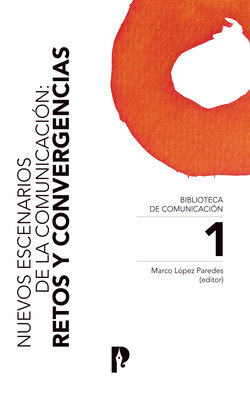Читать книгу Nuevos escenarios de la comunicación - Marco López Paredes - Страница 6
На сайте Литреса книга снята с продажи.
ОглавлениеREFERENCIAS
Bering, J. (2011). El instinto de creer. La psicología de la fe, el destino y el significado de la vida. Barcelona: Paidós.
Boyer, P. (1990). Tradition as truth and communication. A cognitive description of traditional discourse. New York: Cambridge University Press.
https://doi.org/10.1017/CBO9780511521058
Boyer, P. (2003). Science, erudition and relevant connections. Journal of Cognition and Culture, 3(4), 344-358.
https://doi.org/10.1163/156853703771818109
Boyer, P. (2011). From Studious Irrelevancy to Consilient Knowledge: Modes of Scholarship and Cultural Anthropology. En E. Slingerland & M. Collard (Eds.), Creating consilience: Integrating the sciences and the humanities (pp. 113-129). New York: Oxford University Press. https://doi.org/10.1093/acprof:oso/9780199794393.003.0006
Boyer, P. (2013). De una cuidada irrelevancia a la integración del conocimiento. Mesa Redonda, 6, 7-28.
Calhoun, C. (2011). Communication as social science (and more). International Journal of Communication, 5, 1479-1496.
Chaffee, S., & Metzger, M. (2001). The end of mass communication? Mass Communication & Society, 4(4), 365-379. https://doi.org/10.1207/S15327825MCS0404_3
Coetzee, J. M. (2000). Desgracia. Barcelona: Mondadori.
DeFleur, M. L. (1998). Where have all the milestone gone? the decline of significant research on the process and effects of mass communication. Mass Communication & Society, 1(2), 85-98.
https://doi.org/10.1080/15205436.1998.9677848
Dennett, D. (2007). Romper el hechizo. La religión como fenómeno natural. Buenos Aires: Katz Editores.
De Sousa, R. (2007). Why think? Evolution and the rational mind. New York: Oxford University Press.
Epstein, J. (2014). A literary education and other essays. Edinburg: Axios Press.
Fink, E., & Ganz, W. (1999). Análisis de contenido de tres tradiciones de investigación en comunicación masiva: Ciencia social, estudios interpretativos, y análisis crítico”. Talón de Aquiles, 7, 2-18.
Gross, L. (2011). Introduction to the special section: Communication as the discipline of the 21st century. International Journal of Communication, 5, 1497-1498.
Hack, S. (2008). Ciencia, sociedad y cultura. Ensayos escogidos. Santiago: Ediciones de la Universidad Diego Portales.
Hacking, I. (1999). The social construction of what? Cambridge: Harvard University Press.
Hannan, J. (2012). Philosophical profiles in the theory of communication. Berna: Peter Lang. https://doi.org/10.3726/978-1-4539-0202-8
Hauser, M. (1996). The evolution of communication. Cambridge, MA: MIT Press.
Kahneman, D. (2012). Pensar rápido, pensar despacio. Barcelona: Debate.
Koertge, N. (2009). Filosofías New Age de la Ciencia: Constructivismo, Feminismo y Postmodernismo. En E. Otero (Ed.), Filósofos actuales de habla inglesa (pp. xx). Santiago: Ediciones de la Universidad Diego Portales.
Levitin, Daniel J. (2016). This is your brain con music. New York: Dutton.
Mattelart, A., & Mattelart, M. (1997). Historia de las teorías de la comunicación. Barcelona: Editorial Paidós.
McCauley, R. N. (2011). Why religion is natural, and science is not. New York: Oxford University Press.
Mercier, H., & Sperber, D. (2009). Intuitive and Reflective Inferences. En J. Evans & K. Frankish (Eds.), In Two Minds: Dual Processes and Beyond (pp. 149-170). New York: Oxford University Press.
https://doi.org/10.1093/acprof:oso/9780199230167.003.0007
Meyen, M. (2012). The founding parents of communication: 57 interviews with ICA fellows. An introduction. International Journal of Communication, 6, 1451-1459.
Mithen, S. (2006). The singing neanderthals. The origins de music, language, mind and body. Cambridge: Massachusetts: Harvard University Press.
Norris, Pippa and Inglehart, Ronald (2009). Cosmopolitan Communications. Cultural Diversity in a Globalized World. New York: Cambridge University Press.
Otero, E. (2006). El estado del arte en teoría de la comunicación: Un enfoque kuhniano. Intercom, Revista Brasileira de Ciencias de la Comunicacao, 29(1), 57-83.
Otero, E. (Ed.) (2009). Filósofos actuales de habla inglesa. Santiago: Ediciones de la Universidad Diego Portales.
Otero, E. (2010). Sobre la condición fragmentaria y menesterosa de los estudios en comunicación. Cuadernos de Información, 27, 7-14.
Otero, Edison (2017). La caja negra de la tecnología y la comunicación. Anales del Instituto de Chile, Vol. XXXVI, págs. 119-132. https://doi.org/10.7764/cdi.27.18
Peters, J. D. (1986). Institutional sources of intellectual poverty in communication research. Communication Research, 13 (4), 527-559. https://doi.org/10.1177/009365086013004002
Peters, J. D. (2011). Sweet lemons. International Journal of Communication, 5, 1467-1471.
Peters, J. D. (2012). Afterword. Doctors of Philosophy. En J. Hannan (Ed.), Philosophical profiles in the theory of communication (pp. 499-510). New York: Peter Lang
Piedra, Y. (2010). Campo científico de la comunicación: Examinando su estructura intelectual a través del análisis de cocitación. Revista Latina de Comunicación Social, 65, 204-213.
Pinker, S. (1995). The language instinct: How the mind creates language. New York: HarperCollins Publishers.
Pinker, S. (2002). The blank slate. The modern denial of human nature. New York: Penguin Books.
Pooley, J. D. (2011). Another plea for the university tradition: The institutional roots of intellectual compromise. International Journal of Communication, 5, 1442-1457.
Popper, K. (1997). El mito del marco común. En defensa de la ciencia y la racionalidad. Barcelona: Paidós.
Reynoso, C. (2009). Apogeo y decadencia de los estudios culturales: Una visión antropológica. Barcelona: Gedisa.
Rogers, E. M. (1999). Anatomy of the two subdisciplines of communication study. Human Communication Research, 25(4), 618-631. https://doi.org/10.1111/j.1468-2958.1999.tb00465.x
Rosengren, K. (1993). From field to frog ponds. Journal of Communication, 43(3), 6-17. https://doi.org/10.1111/j.1460-2466.1993.tb01271.x
Searle, J. (2003). La universidad desafiada: El ataque postmodernista en las humanidades y las ciencias sociales. Santiago: Bravo-Allende Editores y Universidad Central.
Slingerland, E, &, Collard, M. (Eds.) (2011). Creating consilience. Integrating the sciences and the humanities. New directions in cognitive science. New York: Oxford University Press.
https://doi.org/10.1093/acprof:oso/9780199794393.003.0001
Slingerland, E., & Collard, M. (2011). Introduction: Creating Consilience: Toward a Second Wave. En E. Slingerland & M. Collard (Eds.), Creating consilience: Integrating the sciences and the humanities (pp. 3-41). New York: Oxford University Press.
Snow, C. P. (1959). The two cultures and the scientific revolution. New York: Cambridge University Press.
Sokal, A., & Bricmont, J. (1999). Imposturas intelectuales. Paidós: Barcelona.
Sperber, D., & Deirdre W. (1995). Relevance. Communication and cognition. Oxford: Blackwell Publishers.
Thagard, P. (2013). Pensamiento crítico y lógica informal: Perspectivas neuropsicológicas. Mesa Redonda, 7, 7-26.
Wang, G. (2011). Paradigm shift and the centrality of communication discipline. International Journal of Communication, 5, 1458-1466.
Wolpert, L. (2006). Six impossible things before breakfast. The evolutionary origins of belief. New York: Norton & Company.
